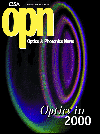A BEC is a coherent collection of particles obeying
Bose-Einstein statistics and all occupying the same quantum mechanical
state. Since the particles in a BEC are all described by the same
quantum mechanical wave function, they behave as a single quantum
entity. Closely related macroscopic quantum phenomena include
superfluidity and superconductivity. Though the existence of a BEC
was postulated early in the previous century, it was not until 1995
that Bose-Einstein condensation was achieved in the laboratory using
magnetically confined alkali atoms. For an extremely dilute gas of
atoms relevant to current experiments, the transition to such a state
occurs at submicrokelvin temperatures. Indeed, the coldest
temperature achieved to date, three billionths of a degree above
absolute zero, is required in order to form a BEC of 85 Rb atoms.
BECs offer great promise for
the precision measurement applications that are at the core of NIST's
mission. Several groups in the NIST Physics Laboratory are currently
working on different aspects of BEC and the physics of quantum gases.
This is transfer function based. For 2D data, the low density regions are
dark and the high density regions are bright. For 3D data, the low density regions are
bright and the high density regions are dark.
Theoretical aspects of Bose-Einstein condensates are investigated
by conducting computer simulations of their behavior. Scientific
visualization techniques are employed in order to examine the large
amount of data generated by simulation. Visualization of this
simulated data demonstrates theoretical predictions, influences the
research process, accelerates scientific understanding, and stimulates
further investigation.
One focus of physics research at the
National Institute of Standards and Technology (NIST) is the behavior
of magnetically trapped BECs of alkali atoms that are subjected to
rotation. One of the long-standing conjectures of many-body physics
is that BECs of interacting particles should be a superfluid, with
properties similar to those of liquid 4 He(II). One key prediction is
that the confined BEC forms quantized vortices when subjected to an
external torque. To explore this possibility, researchers at NIST
perform computer simulations of BECs in rotating magnetic traps. Two
experimental groups confirm that vortices may be produced this way in
confined BECs, though there remain some interesting discrepancies
between theory and experiment. Because of the large amount of data
generated by simulation and the inherently small size of vortices in
condensates, visualization provides not only an effective method for
the detection of quantized vortices, but also for the investigation of
vortex dynamics in these systems.
This visualization:
 |
Showed the existence of quantized vortex array structures.
|
 |
Showed the spontaneous decay of a soliton into concentric quantized vortex rings (a "snake" instability).
|
 |
Created a feedback loop from the visualization process to the simulation research.
|
|
|
|
Peter M. Ketcham, David L. Feder, "Visualizing Bose-Einstein Condensates", [postscript], [pdf], Computing in Science and Engineering, Volume 5, Number 1, January-February, pages 86-89, 2003.
James S. Sims, John G. Hagedorn, Peter M. Ketcham, Steven
G. Satterfield, Terence J. Griffin, William L. George, Howland
A. Fowler, Barbara A. am Ende, Howard K. Hung, Robert B. Bohn, John
E. Koontz, Nicos S. Martys, Charles E. Bouldin, James A. Warren, David
L. Feder, Charles W. Clark, B. James Filla, Judith E. Devaney, Accelerating
Scientific Discovery Through Computation and Visualization, NIST
Journal of Research, vol 105 (6), pp 875-894, Nov.-Dec. 2000 .
 |
| Decay of a dark soliton into vortex rings in a Bose-Einstein condensate |
 |
| Cover of Physics Today, December 1999 |
 |
| Cover of Optics and Photonics News, Vol 11, no 12;
special issue on optics & photonics in 2000 |
 |
| Appears in December 2000 Scientific American |
|
|












